The kitchen is the heart of your home and the most important room for most homebuyers. It’s also the most stressful room to try to upgrade or remodel, thanks in large part to the seemingly countless options you have for countertops, cabinets and flooring materials. Let us walk you through your choices.
Pictures: Sam Woolley, ec-job, Greenhouse Home Improvements, Girl Cooks World
When I bought my house, a fixer-upper, I knew we’d have to remodel the kitchen eventually. The kitchen layout is awkward and wastes space, floor tiles are cracked and uneven, and the laminate countertops are peeling. Besides fixing those problems, a remodel will make the kitchen work for my family better, with hopefully more room for storage and distinct cooking zones. And kitchen upgrades have a great return on investment so hopefully when it comes time to sell, buyers will appreciate the improvements and the value of our home will be greater. As excited as we are to have this done, I’ve found that having too many choices — quartz or granite? porcelain tile or hardwood? maple or birch veneers? — can be overwhelming. However, when you break each down into their pros and cons, it’s easier to make a more confident decision.
Kitchen Cabinets
The biggest expense in a kitchen remodel tends to be the cabinets, which makes sense, since most of the space in your kitchen is probably going to be taken up by them. Whether they’re custom built, semi-custom, or stock cabinets, the construction materials will play a large part in how much those cabinets cost, what they look like, and how durable they will be in your kitchen.
Interior Cabinet Materials
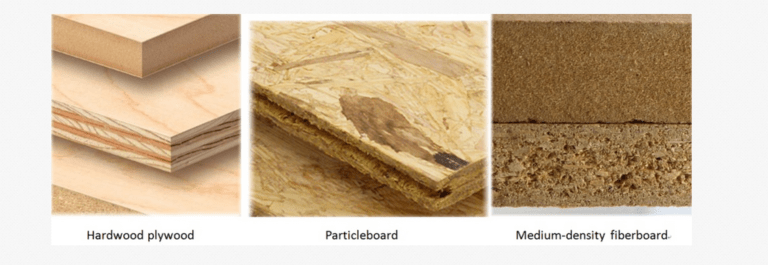
Cabinets with all solid wood doors and cabinets are rare and expensive these days. Most cabinets look like they’re made of wood, but for cost savings they’re actually usually constructed with a different material for the base layer (or substrate) and then covered with wood veneers or plastic laminates. Also, cabinet makers will often use a less expensive material for the sides or backs of cabinets and then use solid wood or a higher grade material for the doors and drawer fronts.
Particle board, MDF and plywood are engineered wood products (“composites”) that are used most often behind wood veneers, laminate or vinyl film to keep costs down.
If you’re on a budget: Particle board is your best bet. It’s the most popular cabinet material and an inexpensive option often in stock cabinets, particularly for base cabinets and shelving.
- Pros: lightweight (easy to work with), inexpensive
- Cons: can expand or discolour due to moisture
If you want the strongest and most durable cabinets: Look for plywood. Plywood is made up of sheets of wood veneer and used for cabinet doors, shelves and boxes. Cabinetmakers use it in their higher-end cabinet lines as an upgrade to MDF or particleboard.
- Pros: stronger and more durable than other options (not susceptible to cracking, shrinking, or warping), supports heavy countertops, easily stained or painted
- Cons: costs significantly more than other options
If you want something sturdier than particle board but less expensive than plywood: Consider MDF cabinets. MDF (medium density fiberboard) is similar to particle board but denser and stronger. It’s manufactured by gluing small wood fibres together at high temperatures.
- Pros: resists warping and stands up to heat and humidity, smooth surface makes it easy to paint
- Cons: also susceptible to moisture problems and can’t be stained, like particleboard (Addicted 2 Decorating calls MDF “basically glorified particle board“)
Costs: According to Old House Web, plywood can cost you 12 per cent more than particle board on average (ranging from 7 to 20 per cent higher). So for $7000 cabinets with particle board, the same with plywood could cost $7700 to $8400, and MDF cabinets would be in between. If you choose from a budget line of cabinets or from a high-end range, you might not have a choice in the base layer material, but it’s good to know the benefits and disadvantages of what you’re getting.
Exposed Cabinet Materials
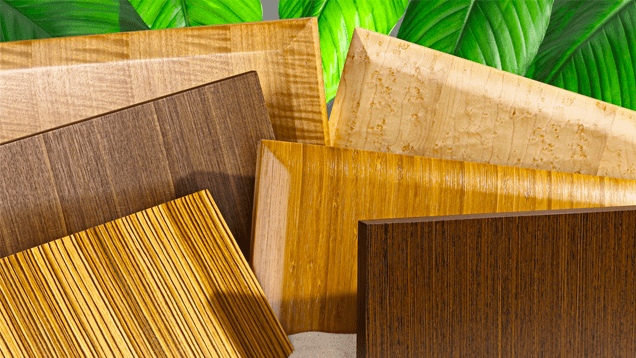
Many people aren’t concerned with how the inside of their cabinets look — it’s the exposed surface that we see all the time that makes a bigger difference in how we see our kitchen, like the door and drawer fronts. If your cabinet bases are fine, refinishing the surface could save you a lot of money.
For more cabinet styles, look to laminates. Laminates are plastic coatings over the cabinet material. They can range from cheap DIY cabinets to higher end versions you’ll find in modern, sleek kitchens. There are options for every budget. (Melamine is similar to laminates: a synthetic material made from wood particles, layers of paper, resins or other glues layered over particle board. It’s used often as cabinet interiors and sometimes exteriors because melamine is easy to clean and more affordable than other options.)
- Pros: easy to care for, virtually indestructible, often affordable
- Cons: can chip or crack easily over time (although high-end laminates are more resistant to damage)
For mid-priced cabinet doors that mimic wood, Thermofoil is a good option. Thermofoil is a flexible vinyl foil pressure-moulded over MDF or particleboard. It’s great for cheaply refacing cabinets for a sleek, white kitchen.
- Pros: mimics realistic wood grain very well, can be moulded into a range of styles, such as arched and cathedral doors, surface is easy to care for
- Cons: can peel off due to heat (especially damaged or discoloured near the stove and microwave)
For a warm and classic look, choose wood or wood veneers. This is your most expensive option, but one that can add the most classic character to your kitchen.
- Pros: can be easily painted or refinished, many wood options (see the differences between red oak, white oak, maple, hickory, cherry and more at BHG)
- Cons: most expensive option, can warp/be affected by moisture
Costs: CostOwl estimates the average kitchen’s wood cabinets to cost between $10,000 and $15,000, while laminate kitchen prices range from $5000 to $8000 — about half as much.
Still can’t decide? Here are Consumer Reports‘ recommendations: Choose solid wood or plywood panels for the doors and drawers and plywood or MDF for the shelves and cabinet boxes:
Doors with solid-wood frames surrounding a solid-wood or plywood panel. Veneered particleboard and medium-density fiberboard (MDF) panels aren’t as good. Avoid laminate or thermofoil over particleboard.
Drawers with solid-wood sides, dovetail joints, a plywood bottom that fits grooves on all sides, and full-extension guide hardware. Hardware that uses undermounted double rollers and integrated side rails isn’t as good.
Shelves made of ¾-inch plywood or MDF. Thinner particleboard shelves might sag over time.
Cabinets made of ½-inch to ¾-inch furniture-grade plywood. MDF is OK, but avoid 3/8-inch coated particleboard.
Mounting strips made of ¾-inch hardwood or metal with bolt holes. MDF, particleboard, and wood that’s thinner than ½ inch can be a problem for heavily loaded wall cabinets.
Kitchen Countertops
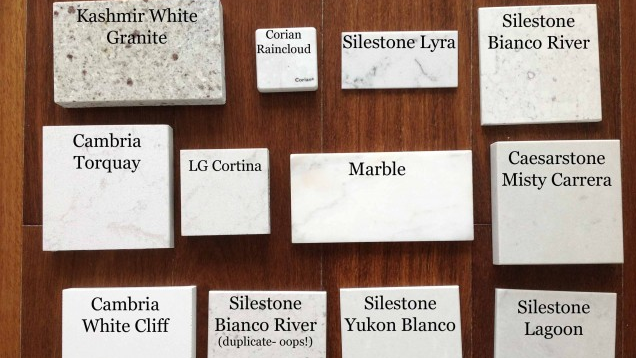
If you thought deciding on cabinets was bad, wait ’til you have to pick out a countertop. There are more than a dozen countertop materials you can choose from, and they’re all a little different. We’re going to sort popular ones here by maintenance, cost and looks.
For the most care-free countertop, choose quartz or manufactured solid surfacing: Quartz is arguably the most durable countertop material. It looks like natural stone and resists scratches and stains, but unlike granite you don’t need to seal it… ever. Other manufactured solid surfaces that look like stone are another option, as they’re also maintenance-free. (If you’re looking for a marble alternative, Girl Cooks World compared marble, quartz, granite and Corian samples in the photo above.)
- Pros: no sealing or special cleaning needed, many colour options
- Cons: solid surfacing and quartz can look artificial, solid surfacing may be susceptible to heat or scratches, both can be pricey
For unique, natural surface countertops, consider granite, marble or soapstone: These surfaces require more maintenance (sealing one or more every year), but they have an undeniable appeal and natural uniqueness.
- Pros: unique patterns and designs, granite and soapstone resist wear and tear, marble resists heat (and is great for bakers), soapstone resists heat and stains (used in Chemistry labs!) and can develop a patina over time
- Cons: pricey, need sealing and protection at least yearly (marble stains easily, soapstone can crack over time)
For budget-tight countertop options, consider tile or laminate: Tile countertops are DIY-friendly and relatively cheap. With larger tiles available today, you can minimise the number of grout lines — and if one tile cracks, it’s easy to replace it. Laminate countertops are also very budget-friendly and low maintenance, but they’re not as durable as other options.
- Pros: porcelain tiles stand up to scratches, stains, and heat well. Laminate countertops are easy to clean and come in a wide range of colours.
- Cons: both are outdated material options. Laminate can be stained, burned, or scratched easily and peel off, while the grout between tile countertops is susceptible to moisture.
Other options: concrete, butcher block, stainless steel: Among the other countertop materials you might consider, concrete, butcher block, and stainless steel are the most popular. They all have different advantages, such as durability (concrete and stainless steel) and a warm, classic look (butcher block), but they’re not as maintenance-free or budget-friendly as some of the other materials.
- Pros: Stainless steel and concrete both stand up to heavy use, and stainless steel is resistant to heat (used in professional kitchens!). Butcher block countertops can be refinished or sanded down to eliminate scratches.
- Cons: Stainless steel is on the expensive side and can dent and show fingerprints, while concrete can crack and stain easily if not sealed often. Butcher block needs regular oiling to protect the surface (especially from water).
Here’s a comparison chart from Great Lakes Granite & Marble:
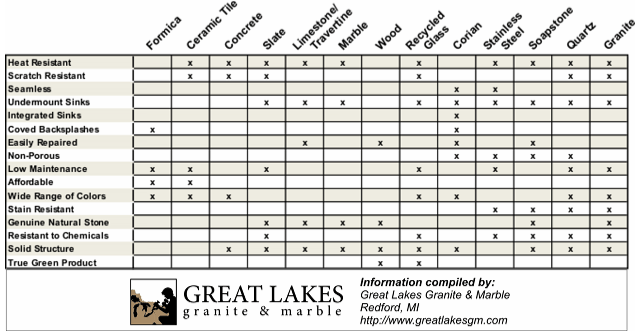
Kitchen Floors

Finally, the third most important material you need to think about when upgrading your kitchen is your floor. In the kitchen, you want a floor that is resistant to humidity, moisture and heat but also comfortable to stand on for long cooking sessions. That’s a tough order.
For the cheapest, easiest to maintain floor, consider vinyl. Sheet vinyl might not be en vogue these days, but it’s maintenance-free for the most part and likely your cheapest option.
- Pros: soft and cushy (so you can stand on it for longer without getting muscle fatigue, compared to other options, and dropped glasses won’t shatter as easily), inexpensive, comes in lots of patterns and can mimic ceramic tile or real stone
- Cons: seams can come apart, trap dirt and let moisture in underneath, eventually the scratch-resistant layer wears off (10-20 years)
For the toughest low-maintenance floor, look to porcelain tile. Porcelain tile is probably the most durable material for your kitchen floor. It’s hard, resists moisture and defies stains.
- Pros: easy to clean, can mimic stone
- Cons: not comfortable to stand on for long periods of time, dropped objects break easily on it
For a natural, traditional look that can tie into the rest of the house, hardwood flooring or similar natural materials are ideal. When you have an open kitchen, it makes sense, design-wise, to carry the wood flooring from the other rooms into the kitchen. Many people avoid hardwood in the kitchen because the humidity and temperature changes can affect the wood floors, but engineered wood planks are able to withstand these better. Cork is another option. It’s eco-friendly, waterproof, and also soft, but, like hardwood, would need refinishing/resealing regularly.
- Pros: comfortable to stand on for long periods, durable and can be refinished
- Cons: need to be resealed/refinished every so often, not as durable as other options
This doesn’t cover the gamut of kitchen options (and let’s not get started on colours, glazes, cabinet hardware or moulding, much less backsplash decisions), but hopefully it’s a starting point if you’re confused by all your options. In the end, your upgrade or remodelling choices will depend on your budget and preferences and how you plan on using the space. Armed with information on material costs and features, you can decide where to splurge and where to save on your kitchen upgrade.
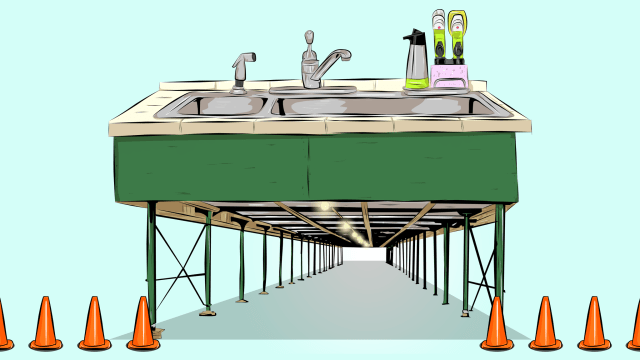
Comments